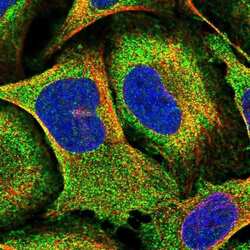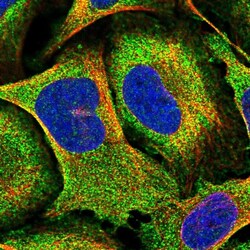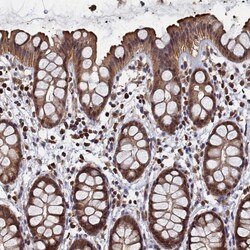Antibody data
- Antibody Data
- Antigen structure
- References [1]
- Comments [0]
- Validations
- Immunocytochemistry [2]
- Immunohistochemistry [1]
Submit
Validation data
Reference
Comment
Report error
- Product number
- PA5-59149 - Provider product page

- Provider
- Invitrogen Antibodies
- Product name
- PIGN Polyclonal Antibody
- Antibody type
- Polyclonal
- Antigen
- Recombinant protein fragment
- Description
- Immunogen sequence: KVDDGVKEIV SMFNHFYGND GKTTFIFTSD HGMTDWGSHG AGHPSETLTP LVTWGAGIKY PQRVSAQQFD DAFLKEWRLE NWK Highest antigen sequence identity to the following orthologs: Mouse - 89%, Rat - 87%.
- Reactivity
- Human
- Host
- Rabbit
- Isotype
- IgG
- Vial size
- 100 μL
- Concentration
- 0.2 mg/mL
- Storage
- Store at 4°C short term. For long term storage, store at -20°C, avoiding freeze/thaw cycles.
Submitted references PIGN-Related Disease in Two Lithuanian Families: A Report of Two Novel Pathogenic Variants, Molecular and Clinical Characterisation.
Siavrienė E, Maldžienė Ž, Mikštienė V, Petraitytė G, Rančelis T, Dapkūnas J, Burnytė B, Benušienė E, Sasnauskienė A, Grikinienė J, Griškevičiūtė E, Utkus A, Preikšaitienė E
Medicina (Kaunas, Lithuania) 2022 Oct 26;58(11)
Medicina (Kaunas, Lithuania) 2022 Oct 26;58(11)
No comments: Submit comment
Supportive validation
- Submitted by
- Invitrogen Antibodies (provider)
- Main image

- Experimental details
- Immunofluorescent staining of PIGN in human cell line U-2 OS shows positivity in plasma membrane & cytoplasm. Samples were probed using a PIGN Polyclonal Antibody (Product # PA5-59149).
- Submitted by
- Invitrogen Antibodies (provider)
- Main image

- Experimental details
- Immunofluorecent analysis of PIGN in human cell line U-2 OS using PIGN Polyclonal Antibody (Product # PA5-59149). Staining shows localization to plasma membrane and cytosol.
Supportive validation
- Submitted by
- Invitrogen Antibodies (provider)
- Main image

- Experimental details
- Immunohistochemical staining of PIGN in human rectum using a PIGN Polyclonal Antibody (Product # PA5-59149) shows moderate cytoplasmic positivity in glandular cells.
 Explore
Explore Validate
Validate Learn
Learn Immunocytochemistry
Immunocytochemistry